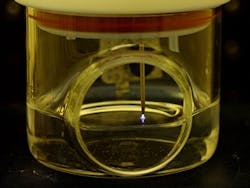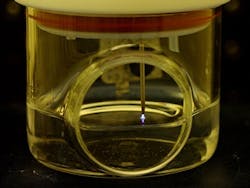Environmentally Friendly Ammonia Production Beckons
A new hybrid route offers a more environmentally friendly way to make ammonia than the commonly used Haber-Bosch process, a highly energy-intensive method using nitrogen, hydrogen gas and an iron catalyst, say researchers at Case Western Reserve University (CWRU), Cleveland.
The approach, developed by professors Mohan Sankaran and Julie Renner, uses an electrolytic process with a plasma (Figure 1) to create ammonia from nitrogen and water at low temperature and pressure, and without using hydrogen or the solid metal catalyst necessary in traditional processes.
“In our system, the ammonia is formed at the interface of a gas plasma and liquid water surface and forms freely in solution,” explains Sankaran.
The researchers took a cue from the Birkeland-Eyde process — which actually predates Haber-Bosch — where nitrogen and oxygen react to produce nitrates. The journal Science Advances contains more detail.
“Our approach is similar to electrolytic synthesis of ammonia, which has gained interest as an alternative to Haber-Bosch because it can be integrated with renewable energy,” notes Sankaran. “However, like the Birkeland-Eyde process, we use a plasma, which is energy intensive. Electricity is still a barrier, but less so now, and with the increase in renewables, it may not be a barrier at all in the future.
Figure 1. A plasma electrolytic system is used to synthesize ammonia from nitrogen and water. Source: Joe Toth, Case Western Reserve University.
“And perhaps most significantly, our process does not produce hydrogen gas,” he stresses. “This has been the major bottleneck of other electrolytic approaches to forming ammonia from water (and nitrogen), the undesirable formation of hydrogen.”
Eliminating the hydrogen and high pressure and temperature makes the process more scalable, adds Renner. The researchers see their process as the ideal kind of technology for a much smaller plant, one with high potential to be powered by renewable energy. “As the technology develops, larger plants could be envisioned,” says Renner.
[callToAction]
The team, which so far only has produced very small batches using their process at an energy efficiency less than that of Haber-Bosch, is optimistic. To achieve lower energy consumption, the Sankaran Lab currently is looking at different reactor designs. “We also aim to elucidate the reaction mechanisms in the coming years,” notes Renner.
This will involve first gaining a deeper fundamental understanding of the process which likely will take 3–5 years, notes Renner. “This knowledge will ultimately aid in reactor design in the future,” she believes.
“While the potential exists to lower the energy consumption of the plasma-based process, ultimately the value of the process may not lie in the energy consumption. It may be attractive because it can directly use renewable energy and can be performed at small scales for distributed ammonia production,” she adds.
The team currently doesn’t have immediate plans to integrate the process with renewable energy, “but it is fun to imagine that one day we will have learned enough to be able to do a demonstration with the windmill located on the CWRU campus,” notes Renner. “A nice first step could be to integrate the process with a battery, making it portable. The battery could be coupled or replaced by renewable energy in the future.”
In addition, purification of the ammonia produced still needs attention. “Process engineering for the balance of [the] plant is a significant yet exciting undertaking,” says Renner.

